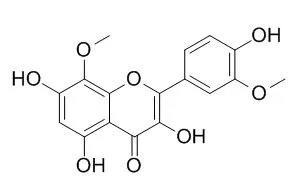Orange peel molasses, a byproduct of juice production, contains high concentrations of phenols, including numerous flavanone and flavone glycosides, polymethoxylated flavones, hydroxycinnamates, and other miscellaneous phenolic glycosides and amines.
METHODS AND RESULTS:
Extensive fractionation of these phenols was achieved by adsorption, ion exchange, and size exclusion chromatography. Size exclusion chromatography effectively separated the different classes of flavonoids in ultrafiltered molasses, including the polymethoxylated flavones, flavanone-O-trisaccharides, flavanone- and flavone-O-disaccharides, and, finally, flavone-C-glycosides. Mass spectral analysis of the early-eluting flavonoid fractions off the size exclusion column revealed a broad collection of minor-occurring flavone glycosides, which included, in part, glycosides of Limocitrin, limocitrol, and chrysoeriol. Most hydroxycinnamates in the molasses were recovered by ion exchange chromatography, which also facilitated the recovery of fractions containing many other miscellaneous phenols. Total antioxidant levels and total phenolic contents were measured for the separate categories of phenols in the molasses.
CONCLUSIONS:
Inhibition of the superoxide anion reduction of nitroblue tetrazolium showed that a significant amount of the total antioxidant activity in orange peel molasses was attributable to minor-occurring flavones.
The miscellaneous phenolic-containing fractions, in which a large portion of the total phenolic content in molasses occurred, also constituted a major portion of the total antioxidants in ultrafiltered molasses. |






 Cell. 2018 Jan 11;172(1-2):249-261.e12. doi: 10.1016/j.cell.2017.12.019.IF=36.216(2019)
Cell. 2018 Jan 11;172(1-2):249-261.e12. doi: 10.1016/j.cell.2017.12.019.IF=36.216(2019) Cell Metab. 2020 Mar 3;31(3):534-548.e5. doi: 10.1016/j.cmet.2020.01.002.IF=22.415(2019)
Cell Metab. 2020 Mar 3;31(3):534-548.e5. doi: 10.1016/j.cmet.2020.01.002.IF=22.415(2019) Mol Cell. 2017 Nov 16;68(4):673-685.e6. doi: 10.1016/j.molcel.2017.10.022.IF=14.548(2019)
Mol Cell. 2017 Nov 16;68(4):673-685.e6. doi: 10.1016/j.molcel.2017.10.022.IF=14.548(2019)